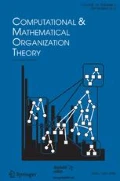Abstract
Sociocultural evolution is defined as the permanent interplay between the evolution of social order, cultural achievements and cognitive ontogenetic development. The key concept is that of social roles that are defined as a set of social rules and role specific knowledge. Sociocultural evolution accordingly is defined as the enlargement and variation of roles and in their social and cognitive dimension and as the variation of the relations between roles. The main theoretical thesis is the hypothesis of heterogeneity: sociocultural evolution is possible only if the degree of role autonomy in a particular society is large enough.
A computational model, the sociocultural-cognitive algorithm is described that captures the main features of the evolution of societies. In particular it can be shown via the model why the hypothesis of heterogeneity is so important: it explains the special way of Western culture that was able totranscendcultural thresholds that limited the evolution of comparable societies.
Similar content being viewed by others
References
Alexander J., B. Giesen, R. Münch and N.J. Smelser, (eds.) (1987), The Micro-Macro-Link. University of California Press, Berkeley.
Berger, P. and T. Luckmann (1966), The Social Construction of Reality. Doubleday, New York.
Bourdieu, P. and J.C. Passeron (1964), Les Héritiers. Les Etudiants et la Culture. Edition de Minuit, Paris.
Dawkins, R. (1976), The Selfish Gene. Oxford University Press, Oxford.
Dennett, D.C. (1995), Darwin's Dangerous Ideas. Evolution and the Meaning of Life. Touchstone, New York.
Farraro, T. (2001), Social Action Systems. Foundation and Synthesis in Sociological Theory. Praeger, Westport CT.
Geertz, C. (1973), The Interpretation of Culture. Basic Books, New York.
Giddens, A. (1984), The Constitution of Society. Outline of the Theory of Structuration. Polity Press, Cambridge.
Habermas, J. (1981), Theorie des kommunikativen Handelns II. Suhrkamp, Frankfurt (M).
Holland, J., K.J. Holyoak, R.E. Nisbett and P. Thagard (1986), Induction. MIT Press, Cambridge, MA.
Klüver, J. and J. Schmidt (1999), “Control Parameters in Boolean Networks and Cellular Automata Revisited: From a Logical and a Sociological Point of View,” Complexity, 5(1), 45–52.
Klüver, J. (2002), An Essay Concerning Sociocultural Evolution. Theoretical Principles and Mathematical Models. Kluwer Academic Publishers, Dordrecht.
Klüver, J. and J. Schmidt (2002), “The Sociocultural Algorithm (SCA),” in J. Klüver An Essay Concerning Sociocultural Evolution. Theoretical Principles and Mathematical Models. Kluwer Academic Publishers, Dordrecht.
Klüver, J., J. Schmidt and C. Stoica (2003), “Formal Models, Social Theory, and Computer Simulations. Some Methodical Reflections,” Journal of Artificial Societies and Social Simulations (JASSS), 6(2).
Kohonen, T. and H. Ritter (1989), “Self-Organizing Semantic Maps,” Biological Cybernetics, 61, 241–254.
Kosko, B. (1987), “Adaptive Bi-Directional Associative Memories,” Applied Optics, 26(23), 4947–4960.
Kosko, B. (1988), “Bi-Directional Associative Memories,” IEEE Transactions of Systems. Man and Cybernetics, SMC-18, 49–60.
Kuhn, T.S. (1962), The Structure of Scientific Revolutions. University of Chicago Press, Chicago.
Lakoff, R. (1987), Women, Fire and Dangerous Things. What Categories Reveal About the Mind. The University of Chicago Press, Chicago and London.
Lansing, S., J.N. Kremer and B.B. Smuts (1998), “System-Dependent Selection, Ecological Feedback and the Emergence of Functional Structures in Ecosystems,” J. Theor. Biology, 192,377–391.
Luhmann, N. (1984), Theorie Sozialer Systeme. Suhrkamp, Frankfurt (M).
Needham, J. (1970), Clercs and Craftsmen in China and the West. Cambridge University Press, Cambridge.
Rasmussen, S., C. Knudsen and R. Feldberg (1992), “Dynamics of Programmable Matter,” in C.G. Langton,.C. Taylor, J.D. Farmer, and S. Rasmussen (Eds.) Artificial Life II. Reading MA: Addison Wesley.
Read, D. (1990), “The Utility of Mathematical Constructs in Building Archaeological Theory,” in A. Voorrips (Ed.) Mathematics and Information Science in Archaeology: A Flexible Framework. Bonn: Holos.
Toynbee, A. (1934-1961), A Study of History (12vols.). Oxford University Press, Oxford.
Author information
Authors and Affiliations
Rights and permissions
About this article
Cite this article
Klüver, J., Malecki, R., Schmidt, J. et al. Sociocultural Evolution and Cognitive Ontogenesis: A Sociocultural-Cognitive Algorithm. Computational & Mathematical Organization Theory 9, 255–273 (2003). https://doi.org/10.1023/B:CMOT.0000026584.19223.ef
Issue Date:
DOI: https://doi.org/10.1023/B:CMOT.0000026584.19223.ef




